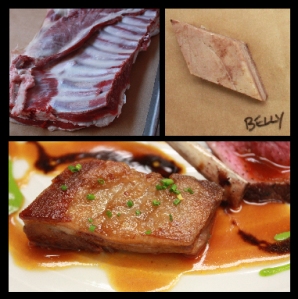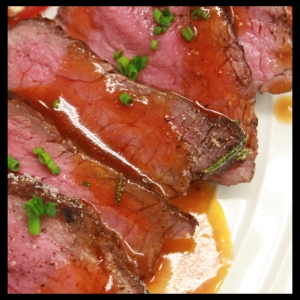Dish of the Week
Crispy Ballantine of Marrow & Pan Roasted Scallop
Summer Corn, Micro Greens & Basil Coulis
Long before we were hunters, we were foragers eating what scraps of meat we could scavenge off fallen prey after the apex predators with full stomachs had moved on. No one knows where the impulse to raise a stone and break the bones of those animals to get to the nutrient rich marrow inside came from, but the fat gleaned from them helped us survive the early winters of our civilization. Many scientists believe the fat-soluble vitamins found in those bones, and the interior columns of marrow, were crucial to hominids developing larger brains.
With the invention of weapons we moved on, to whole animals and choice cuts of meat, but marrow never disappeared from the playing field of cuisine. Every country has classic recipes using it ~ to thicken soups, as a base for sauces, to inspire pasta fillings, or just slathered on bread instead of butter. When served on its own, you usually get the roasted bone with a scoop, a tradition for which we have Louis XV to thank. But whether you eat it off an elegant silver spoon in Monaco (at Alain Ducasse’ Louis XV) or chow down in East London with a platter overflowing with bones in a sea of parsley (at Fergus Henderson's St. John), marrow is delicious. There are some things you put in your mouth ~ oysters and foie gras come to mind ~ when sensation precedes all thought and taste. The flavor of marrow is fragrant and meaty but secondary to its texture, which is incredibly light. It’s fat, yes, but fat with attitude.
When served as an entrée marrow is usually paired with red meat, the classic ‘whole animal’ connection. Makes sense, but ultimately, a bit limiting. After a few bites, with nothing for the rich flavors to play against, umami on umami cancel each other out.
Ryan has found a way around this conundrum by creating a dish that features marrow as a luxurious condiment in a main course. It’s an inspired pairing with scallops that results in a frisson similar to the one you get with Chorizo and Clams ~ disparate ingredients that compliment each other, but ultimately stand alone.
While this week’s DOW is probably not a ‘try this at home dish,’ if you want to cook marrow out of the bone all you need do is soak the bones first in ice water. This will pull any remaining blood out (even yellow marrow will have some), while time in icy water chills the fat making it oh so easy to slide out of the bone. Drew rolls the marrow in sifted flour before sautéing in grape oil and finishing with Maldon salt. Timing is crucial. You need just enough heat to warm the marrow through, stopping just short of its melting point. Drew, always admirably stoic even when facing a full incoming board of orders, handily coordinates a perfect scallop with the perfectly cooked marrow, but it could be nerve wracking for a lesser chef.
This isn’t a straight up surf and turf attraction, but something far more subtle. Ryan's is a very modern presentation which explores marrowfat’s incredible lightness of being, taking it out of the context of the bone altogether. Visually, on its own, marrow is but a white plug of fat, so Chef surrounds it with color ~ a single gorgeously golden pan roasted scallop with late summer corn and a vibrant basil coulis. The dish is finished with a conga line of pungent micro greens with just enough punch in the Russian Kale and Bull’s Blood to refresh the palate.
Reading up on marrow I came across a highly entertaining blog called Mark’s Daily Apple written by a body builder with a discernible jones for primal brain food. No silver spoon for this guy ~ according to Mark Sisson “paleo reenactment is the only justifiable course of action,” when eating marrow. Just have at it, he says, like our ancestors used to. He (and Fergus) have a point, but when it comes to the evolution of this remarkable ingredient, I think I’ll stick with Ryan.
Best of the Blogs this Week...
No one would argue that Barndiva isn't extremely photogenic, but though we see ourselves frequently in food and weddings blogs we rarely link you to them. Mea Culpa. My extremely talented goddaughter Zem Joquin (ecofabulous.com), no slouch when it comes to all things 'virtual,' implores me to remember the internet is all about SHARING. And hey, it's ok to blow your own horn. I know she’s right, but I fear I come from another time and place. Chef and I have wanted to keep the blog ‘clean’ looking and ad free, with original copy and images every week that aren't just re-posted. But I'm coming around to see that for those of us dedicated to DO EPIC SHIT (more on this next week) we are stronger in numbers.
So here are two blogs that came across the desktop this week I really admired. The first is the beautiful wedding album of Ginger and Pierre, shot by Traci Griffin. By any accounts, this is a pretty stunning couple. But it’s the warmth of these images, which flowed from the wedding couple and every one of their family and friends on the day that makes this album so special. These guys are from New Orleans, so they started with a surfeit of soul, but Traci captured all the sweet details that made this wedding remarkable. The couple even skipped out during the salad course to quickly shoot the fading sunlight of their wedding day in random vineyards and fields around Healdsburg. (It was nice to see Hotel Les Mars in the early shots, and Dragonfly's florals, which captured the casual elegance of the day.)
Amber got an email this week from the newlyweds, back in the Big Easy, bailing out water from Hurricane Issac, still high from their nuptials. No worries: these guys can float.
The second link is to a personal blog by a couple who travels to ride their bikes, eat and drink wine. Lots of it. Not a day goes by I don’t walk through the dining room and see someone lifting a cell phone to take a snap of their meal, and while I think visual diaries are fun (in small doses), rarely do I see blogs as tight as the one Katie posted about her and Whit's trip to Sonoma on her blog, Is There Any Wine Left?. Was it laudatory? You bet. Would I have posted it if it weren’t? Probably not, but I sleep better knowing there are bloggers out there who put real time and effort into relaying their lives to friends, especially when what we do is involved. There is so much crap on the internet. And while we’re long past the point of thinking every image taken steals our souls (if true, then we have none), I still believe when you come into someone else's house and take an image away, you should try and make it a good one. Katie can write, as well.
Eat the View!
All text Jil Hales. All photos Jil Hales (unless otherwise noted.)

























